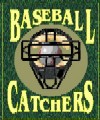When setting up to receive a throw to the plate, a catcher
should put his foot on the third base line.
His knee should be pointing
directly at the runner. If his knee is pointed away from the runner and
a collision occurs, there is a greater chance the catcher will be injured.
If his knee is pointed at the runner, a catcher has a more solid stance with less
give in the knee.
After catching the ball, the catcher should attempt to tag the runner
with both hands; hand on ball, ball in glove. If it appears a collision
is going to occur the catcher should lower his center of gravity and
stay low. Just like in football, low man usually wins. |
 |


